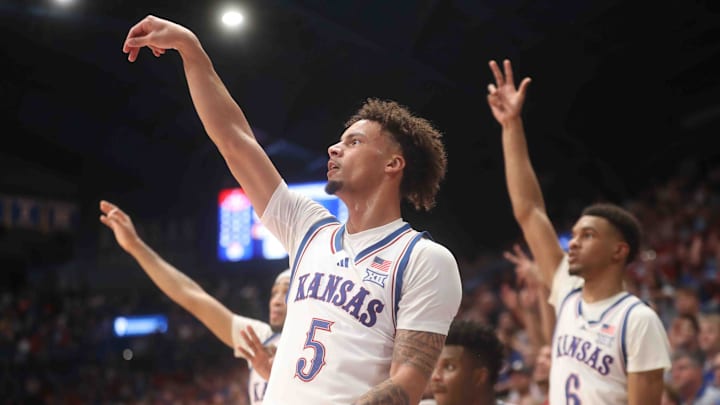Men’s College Basketball: Best- and Worst-Case Scenarios for AP Preseason Top 25

- Kansas Jayhawks
- Alabama Crimson Tide
- UConn Huskies
- Houston Cougars
- Iowa State Cyclones
- Gonzaga Bulldogs
- Duke Blue Devils
- Baylor Bears
- North Carolina Tar Heels
- Arizona Wildcats
- Auburn Tigers
- Tennessee Volunteers
- Texas A&M Aggies
- Purdue Boilermakers
- Creighton Bluejays
- Arkansas Razorbacks
- Indiana Hoosiers
- Marquette Golden Eagles
- Texas Longhorns
- Cincinnati Bearcats
- Florida Gators
- UCLA Bruins
- Kentucky Wildcats
- Ole Miss Rebels
- Rutgers Scarlet Knights
1. Kansas Jayhawks
Best case: Bill Self loading up on wing scoring pop in the transfer portal pays off, making last year’s disappointment an aberration and elevating the Jayhawks back to serious national contenders.
Worst case: Jayhawks star big Hunter Dickinson has been the centerpiece of teams that have underachieved three years in a row. Can KU build a title-winner around him?
2. Alabama Crimson Tide
Best case: Rutgers transfer Clifford Omoruyi fixes the Tide’s interior defense from a year ago, and Nate Oats’s team makes a jump from Final Four squad to title-winner.
Worst case: Alabama’s offense is very reliant on the three-point shot, and perhaps some regression hits the likes of Mark Sears and Latrell Wrightsell Jr. In a loaded SEC, that could knock them down a few spots.
3. UConn Huskies
Best case: Dan Hurley pressed the right buttons in the spring yet again, and the Huskies make a serious push towards a historic three-peat even with four new starters.
Worst case: Too much roster turnover for even a coach like Hurley to handle. That might not stop them from pushing for a Big East crown, but a third straight national title will be tough to pull off.
4. Houston Cougars
Best case: With four starters back including star guards LJ Cryer and Emanuel Sharp, Kelvin Sampson finally breaks through for his first national title after four straight top-five KenPom finishes.
Worst case: The Cougars have gotten rock-solid point guard play during this dominant four-year stretch. If Oklahoma transfer Milos Uzan doesn’t take the reins effectively, that would bring down UH’s ceiling.
5. Iowa State Cyclones
Best case: The Cyclones stay dominant on defense and take a jump offensively thanks to an experienced backcourt led by junior point guard Tamin Lipsey.
Worst case: It has been a decade since a team with an offense outside the top 10 on KenPom won a national title, and the Cyclones don’t have the firepower to seriously contend to win it all.
6. Gonzaga Bulldogs
Best case: You couldn’t have scripted a better offseason for Gonzaga with retention and key portal adds. That translates on the court and elevates the Zags into a top-tier contender.
Worst case: Big man Graham Ike has been dominant in his career when healthy, but injuries have been a consistent disruptor. If he can’t stay on the floor, it’d be a huge blow.
7. Duke Blue Devils
Best case: Cooper Flagg lives up to the hype … and more. With Flagg as a centerpiece and talented role players around him, Duke makes a championship push.
Worst case: Flagg won’t turn 18 until midway through the season, and Duke is putting a ton on a player who’ll be among the youngest in the sport this season.
8. Baylor Bears
Best case: Scott Drew meshes youth (five-star VJ Edgecombe) with experience (transfers Norchad Omier and Jeremy Roach) masterfully.
Worst case: Defense is again the Bears’ Achilles heel, just as it has been the last two seasons. You can’t win a title while being a liability on that end of the floor.
9. North Carolina Tar Heels
Best case: National Player of the Year candidate RJ Davis leads the way, but UNC’s role players shine like they did a year ago.
Worst case: Missing on top targets to replace center Armando Bacot in the transfer portal comes back to bite Hubert Davis and company in Chapel Hill.
10. Arizona Wildcats
Best case: Coach Tommy Lloyd added plenty of physicality to his rotation in anticipation of Arizona’s move to the Big 12, and that toughness translates into March success.
Worst case: Enigmatic star guard Caleb Love has one more catastrophic NCAA tournament showing that leads to an early exit.
11. Auburn Tigers
Best case: Already armed with one of the best centers in college basketball in Johni Broome, Bruce Pearl’s backcourt upgrades in the portal elevate Auburn to new heights.
Worst case: The Tigers can’t ditch the inconsistency that plagued them a year ago, including in its disastrous first round NCAA tournament loss to Yale.
12. Tennessee Volunteers
Best case: No one can replicate Dalton Knecht’s impact, but North Florida transfer Chaz Lanier might be able to come close.
Worst case: The Vols go from an incredibly veteran group to one that features plenty of fresh faces. Without as much roster continuity, the Vols can’t keep up with the top of the SEC.
13. Texas A&M Aggies
Best case: Wade Taylor IV has a bounceback year from an efficiency standpoint now that he has a capable backcourt running mate in SMU transfer Zhuric Phelps.
Worst case: Losing Tyrece Radford, the heart and soul of the Aggies under Buzz Williams, hurts far more than the box score might indicate.
14. Purdue Boilermakers
Best case: Braden Smith blossoms into one of the nation’s best point guards and pushes Purdue back to the top of the Big Ten, even without Zach Edey.
Worst case: Without the attention Edey attracted on every possession, Purdue’s role players from a year ago look a lot more ordinary.
15. Creighton Bluejays
Best case: Keeping Ryan Kalkbrenner means the Bluejays will still be an elite rim defense, and Greg McDermott’s team has plenty of shooting to surround Kalkbrenner.
Worst case: It will be hard to be as efficient offensively as CU was a year ago without Baylor Scheierman and Trey Alexander leading the way.
16. Arkansas Razorbacks
Best case: John Calipari gets his swagger back in Fayetteville, riding a mixture of portal stars like Johnell Davis with young talent to push for an SEC title.
Worst case: Calipari brings his recent March woes with him, and a lack of knockdown three-point shooters could also be a concern for this group.
17. Indiana Hoosiers
Best case: A revamped roster gives Mike Woodson the bounceback year the Hoosiers desperately need, with Washington State transfer point guard Myles Rice and former Arizona big Oumar Ballo leading the way.
Worst case: Woodson’s dated style doesn’t change much, even with better personnel than a year ago. The Hoosiers stay in the middle of the pack in the Big Ten, putting Woodson on the hot seat.
18. Marquette Golden Eagles
Best case: Shaka Smart’s big bet on internal improvement pays off, and the Golden Eagles remain near the top of the Big East despite losing Tyler Kolek and Oso Ighodaro to the pros.
Worst case: Outside of star guard Kam Jones, there just aren’t enough offensive weapons. Smart’s club slumps back towards the bubble.
19. Texas Longhorns
Best case: Freshman Tre Johnson lives up to the lofty preseason hype and gives the Longhorns serious star power to go with a veteran transfer-laden nucleus.
Worst case: There’s only one ball to go around between Johnson and high-volume transfers Jordan Pope, Arthur Kaluma and Tramon Mark, and it’s hard to get all of them playing at the top of their games.
20. Cincinnati Bearcats
Best case: After 10 losses by five points or less a year ago with a young group, the Bearcats break through in 2024–25 and push for Big 12 contention.
Worst case: Wes Miller’s club can’t kick the shooting woes that plagued them a year ago, dooming the Bearcats to a middling campaign.
21. Florida Gators
Best case: Australian big Alex Condon explodes in his second year in the Gator system, pairing with a talented backcourt to keep the Florida program rising under Todd Golden.
Worst case: Golden’s staff can’t replicate last year’s incredible portal haul and ends up not surrounding guard Walter Clayton Jr. with enough talent.
22. UCLA Bruins
Best case: The Bruins’ incredibly deep roster settles into roles quickly, with transfers like Skyy Clark and William Kyle injecting life into a what was a dormant offense a year ago.
Worst case: Mick Cronin may have more options than he did a year ago, but this group’s lacking star power prevents them from climbing the ladder in the Big Ten.
23. Kentucky Wildcats
Best case: Mark Pope’s shooting-first approach in the transfer portal pays off, producing a winner in Year 1 despite a lack of star power.
Worst case: Meshing together an entirely new roster is a gargantuan challenge … especially in a program with the spotlight of Kentucky’s. Some struggles early shouldn’t be a shock.
24. Ole Miss Rebels
Best case: Chris Beard went to the Elite Eight in his second year at Texas Tech. With a talented crop of newcomers, Beard gets the Rebels on a similarly rapid upward trajectory.
Worst case: Beard can’t fix the Rebels’ defensive woes from a year ago, leaving Ole Miss fighting just to sneak into the NCAA tournament.
25. Rutgers Scarlet Knights
Best case: Freshman sensations Dylan Harper and Ace Bailey are impactful from Day 1, even against older foes. That once-in-a-lifetime talent injection lifts the Scarlet Knights to a historic campaign.
Worst case: Relying on 18-year-olds in today’s college basketball is less than ideal, and the Knights don’t have enough shooting around their two freshmen stars to accentuate their strengths.
